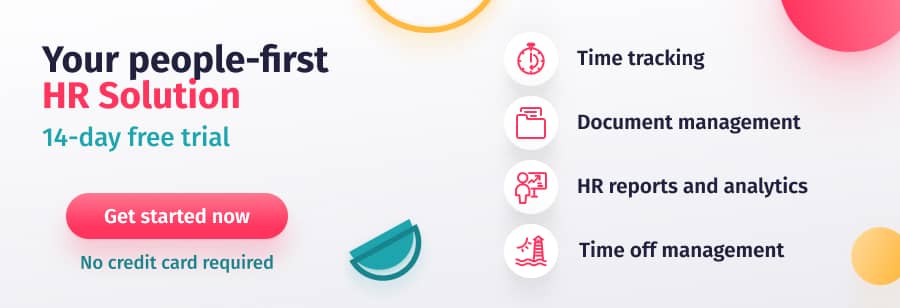Whether it’s handling purchase orders, invoices, or employee data, it is vital to have a reliable system in place for efficient document management. With this in mind, many organizations choose to implement an electronic document management system (EDMS) to ensure all data is readily available, securely stored, and easily accessible whenever needed.
An EDMS also offers businesses additional benefits including compliance and the automation of daily processes. This enables employees to focus on more strategic tasks, including innovation, collaboration, and communication.
Today we are going to explore how an EDMS can benefit every level of your business.
What is EDMS?
First things first, what does EDMS stand for?
EDMS is short for Electronic Document Management System. Put simply, it is software used for internal document management, as part of a wider business and human capital management strategy. Compared to other HR solutions which aim to streamline specific internal processes (HR SaaS applications), an EDMS serves to centralize an organization’s documents at every level of the company. This includes employee files, internal policies, invoices, manuals, contracts, purchase orders, and data from talent acquisition platforms, amongst other internal document types.
An EDMS is usually hosted on a company’s internal server or on the cloud. Users can save documents on the server and easily search for them at a later date from a range of devices. By storing data on a single digital repository, you get easy data access, streamlined collaboration, increased compliance, and simplified document version control. And all this, ultimately, results in increased efficiency and ROI.
EDMS features
Now that we’ve looked at the EDMS meaning, let’s explore some of the key features you can find in an electronic document management system:
- Creation and digitalization of documents
- Scalable and centralized document storage
- Organization of files with tagging systems, metadata searching, and folders
- Automatic and/or manual backup and archiving processes
- Document control systems
- Access controls
- Collaborative tools for easy sharing and live editing features
- Advanced security protocols
- Features for managing document and record lifecycles
- Internal and external file sharing capabilities
- Searches across multiple resources and platforms
- Tools for tracking document history and system activity
- Integration of EDMS tools with other platforms, such as expense management software tools, applicant tracking systems, employee database software, employee clock-in systems, HR onboarding software, employee self-service portals, predictive analytics software for HR, and people management software solutions, amongst others.
Why use an electronic document management system?
Implementing an electronic document management system provides a number of benefits, as we will see in more detail below. Put simply, it offers you increased security, efficiency, transparency, and productivity. It helps your company stay organized, and it helps your employees reclaim valuable time, boosting your bottom line. It also reduces the chances of data going missing, helping your business run smoothly and stay compliant.
So, who makes the choice to implement an EDMS system? When is the best time to invest in HRMS software such as an EDMS?
It varies.
EDMS deployments are often initiated by IT departments with the aim of standardizing data management practices between departments. For example, one department might be storing information on local devices, and another might be using an unsecured shared drive. The result of this is that departments are unable to access data managed by other business areas when needed. Instead of simply accessing a shared repository when they need something, they have to specifically request information, which often results in delays.
Another reason for implementing an EDMS system might be because you have decided to move from physical to digital storage. This might be because of mounting archiving costs or simply because you are running out of office space. Plus, by digitalizing all your files, you also open up the possibility of automating your processes and gaining valuable insight into your business operations.
Here are a few other common pain points that can encourage companies to implement EDMS software to digitalize and organize their internal documents:
- Time-consuming document search and retrieval
- Creation of information silos across departments that make it difficult to make data-driven decisions
- Consistent data-related delays and inefficiencies in core business processes
- Data breaches or errors resulting from manual document processing
- Security concerns and vulnerabilities
How to use an electronic document management system
It’s important that you keep your electronic document management system as organized and up to date as possible. An EDMS aims to ensure your staff members can easily locate whatever they need at the click of a button. Even if the data they are looking for was filed away many years ago.
Think of it like this: if one of your employees is absent, you need to be able to easily locate any documents created or managed by them without resorting to sending them a message and waiting for a response. In other words, your EDMS needs to be intuitive, instinctive, and user-friendly.
There are a number of best practices you can establish in order to get the most from the tool. These tips help you create a logical and intuitive system where all data can be easily located and accessed by any member of staff. Make sure you offer all your employees EDMS training so that they are aware of these guidelines:
- Create a single root folder (“Shared Documents”, for example) and store all documents in subfolders inside the root folder. This makes it easier to find things and run backups and archives.
- Create folders in a logical hierarchy, and nest folders within folders.
- Establish and follow file naming conventions. Use logical, specific names and include dates in file names. You should be able to instantly know what a file is without opening it.
- Create a document management strategy. This plan should detail guidelines for all aspects of handling documents, including storage, retrieval, backups, and security.
-
Make sure everyone has training so that they are aware of these guidelines.

EDMS system benefits
The most obvious advantage of using an EDMS that you will initially see is that you will dramatically reduce the volume of paper you need to purchase in order to manage your internal processes. By digitalizing your records, you also remove the need for physical archiving, helping you regain space and reducing costs for your business.
It doesn’t stop there, though.
Let’s finish today’s post by exploring some of the biggest benefits of implementing an electronic document management system such as the one included in Factorial’s all-in-one HR solution. You can find out more about how the range of features included in Factorial’s software solution can help your business here.
Improved efficiency
Instead of wasting time digging through filing cabinets or requesting information from other departments, your employees can find exactly what they need whenever they need it, across multiple repositories, devices, and document formats. They can also use automated processes and document indexing features to extract data faster. This streamlines your workflows and reduces bottlenecks, helping your day-to-day business run more smoothly and efficiently and, ultimately, saving you time and money.
Multi-platform capabilities
With the increase in remote and hybrid working models and the range of devices used by employees these days, it can be difficult to keep track of all your data. A remote worker might save documents on their personal laptop, for example. Or a salesperson might save that all-important invoice to their phone. The only way to get hold of this data when you need it is to contact them and hope that they respond quickly.
In contrast, with an EDMS, data can be stored in a centralized repository from any device and any location. This helps to ensure data integrity, content management, and document control across multiple devices and locations.
Has the document you’re looking for been managed by someone working on the other side of the world? No problem. Just access the digital repository and you can download what you need at the click of a button.
Security and compliance
One of the biggest benefits of embracing digital transformation and implementing an electronic document management system is that you get increased security and compliance. The best solutions include tools for you to set permissions and control document access to facilitate ongoing compliance, reducing the risk of data breaches, document loss, and compliance infractions. This is especially important if your business operates in a controlled environment or a highly regulated industry. For example, finance or health care.
Increased collaboration
An electronic document records management system can make it easier for your employees to collaborate together. For example, many solutions include features for markup options such as annotations and stamps, version control, and simultaneous document editing. This means that employees can work together on document changes, regardless of physical location. This helps you make more informed business decisions and makes it far easier for your employees to work together as a team.
Data integrity
Finally, an EDMS can help you ensure the integrity of your data, creating a single source of truth. Thanks to collaborative features like version and access control, you can be sure that the information you have stored is relevant, true, and up to date. This improves the accuracy of your business data so that you can make better-informed decisions. It also drastically reduces the chances of human error resulting from out-of-date information, incomplete data, or incorrect active versions. And this, ultimately, helps your business run more smoothly, boosting your bottom line.
written by Cat Symonds


